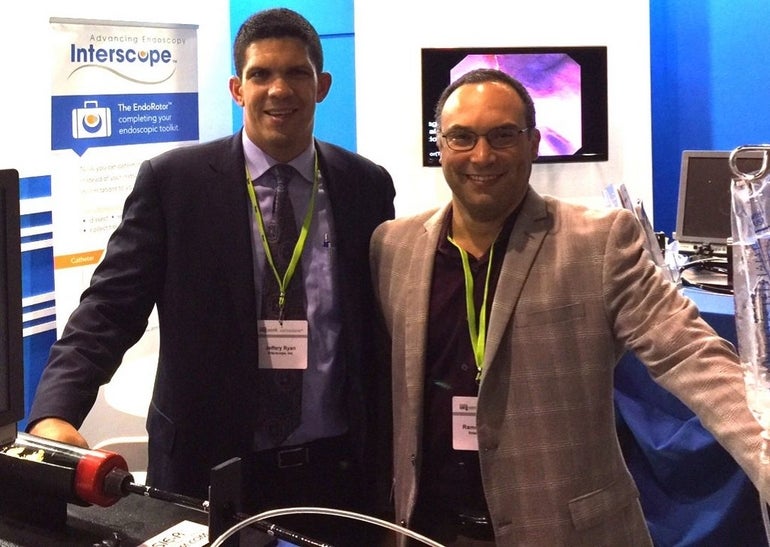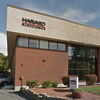After European roll out, Interscope looks towards FDA approval
 Courtesy
Jeffery Ryan and Ramon Franco, co-founders of Interscope, Inc.
Courtesy
Jeffery Ryan and Ramon Franco, co-founders of Interscope, Inc.
When the Affordable Care Act started to take shape, Jeff Ryan and Ramon Franco saw an opportunity in the medical device field. Inspired by the part of the law focused on preventative care, the two men realized a need for medical devices that make it easier to remove lesions early on. Their company, Worcester-based Interscope, Inc., is the developer of the EndoRotor System, an endoscopic device that streamlines interventional gastrointestinal procedures used to manage colon and esophageal cancer. The system has European Union approval, and the company hopes to have U.S. Food and Drug Administration (FDA) approval completed next year.
Ryan, one of the co-founders, spoke about founding the company, expanding the workforce and next steps.
You are a co-founder of Interscope. Tell me about how you and your partner founded the company.
My business partner is Ramon Franco. He’s an otolaryngologist (ear, nose and throat surgeon) by trade, and he and I were friends for several years before. We had noticed some changes -- some industry trends relative to physician practice and to the medical device market. We decided we wanted to incorporate those and go out on our own.
This was before the inception of the company as it is now. But our basic premise was, "There are things that are changing, so let’s do something about it."
What was changing?
At the time, the Affordable Care Act was going through its early stages. We thought the changes the law was going to potentially introduce to the system could result in some positives and negatives. One thing that was going to change was the need for more preventative care was going to increase. Because of that need, we said, "This is where we need to be."
How did all of that develop into a company?
We used that idea to create our baseline mission statement, which is to impact patient care, to "move up the disease state" -- a commonly used phrase in the industry that means to get the disease before it’s really bad. We also wanted to move procedures out of surgery and into the endoscopy room or earlier care. For example, if you have a patient with colon cancer, they usually need surgery. If we can improve a physician’s ability to remove a disease early, the likelihood of patients needing that surgery is going to be reduced.
How did the company come together?
The company started in 2011. We had initially myself and Ramon, and we had a consultant engineer, Cosme Furlong. We had to figure out if our initial ideas were physically possible and figure out what the intellectual property landscape was like. Has anybody done this, and can it be done?
We set out to make devices specifically for challenging diseases of the colon. We expanded on that because physicians told us it could have other applications in gastroenterology. They say, "We can use your device in the esophagus and in the stomach," so we expanded in our initial scope, based on the users.
We can go into urology -- that’s on the next forefront -- though we would have to make modifications. At this moment, we are laser focused on our first target market, which is gastroenterology.
How many employees do you have?
We will have five by the end of the month. Right now it’s myself, Ramon, an international vice president of marketing and sales, and our quality manager. We’re bringing on a vice president of research and development. We conducted interviews for that position over the last couple of weeks.
The new person is to facilitate our second generation agreement. To bring engineering functions and baseline manufacturing functions in house to improve. For us, it’s all about return on investment. We’ve reached a point where we believe in internalizing certain job functions. It’s going to radically improve our capacity to achieve our goals in a timely fashion. And the reason is because we’re so focused. Many companies have many products. We want to at least in some degree internalize it. There’s always going to be a collaborative piece, in terms of working with our supplier manufacturers and outside engineering support. That is the only way we will continue to be successful.
Tell me about your EndoRotor System.
The EndoRotor is a platform technology, and what that means it is it’s one tool, one instrument that has the capability to go many places. We can not only service the entire gastrointestinal tract, from up to down, but it also has new forays into the distal lung. Right now the tools to deal with distal diseases of the lung are very limited.
The EndoRotor gives physicians the capability to remove disease. Right now we use it for gastrointestinal and lung applications, but we have the potential to even go into urology. The story doesn't stop for us. It’s a technology we can improve, and modify, but at the end of the day, it can serve its core function and have many procedural applications.
There are a number of papers out there that show between 20 to as much as 46 percent of the time -- depending on the size of the lesion -- you have lesions that are not completely removed in the colon. Those lesions present a problem, because then physicians have to do a follow on procedure to remove the extra disease they didn't get the first time. This is called tissue persistence, but that can lead to local recurrence. If it recurs and regrows, that can be a problem because the first time they attempted the procedure you leave behind a scar. So then you're dealing with scar lesions in the colon, which becomes very challenging, to the point where physicians have to use many tools and aren't really satisfied with the level of tools that the have. This allowed us to say, "We have a market."
Where do the devices get manufactured?
At Vention Medical in Marlborough. Boston Engineering is also involved with product development and the design for manufacturing process. We had a collaborative effort to design and manufacture the products.
Will you ever do your own manufacturing?
It depends on the needs of the market. I would say our second generation product would be most likely manufactured by us. But currently, we have no intentions of pulling in manufacturing on our legacy portfolio.
What was the significance of EU approval for the EndoScope?
The significance of the EU approval is that we’ve been able to do approximately 50 procedures since April. That clinical evidence is helping to drive U.S. clearance, or FDA clearance. It’s our hope that we can get FDA approval within the next year. Our customers are everywhere in Europe, from as far west to as far east, including Slovenia, Portugal, Spain, France, England, Germany, Italy and Austria. We’re about to move into Poland in the next year. We’re drastically expanding.
What’s next for Interscope?
FDA approval is a big one, and so is further clinical validation for the work that we’ve been doing in Europe. What that means is we’re tracking the studies that we have and recruiting patients. So far with the first patients, we’ve seen that there is high potential for statistically significant improvements.









0 Comments